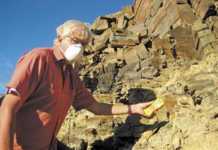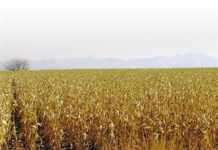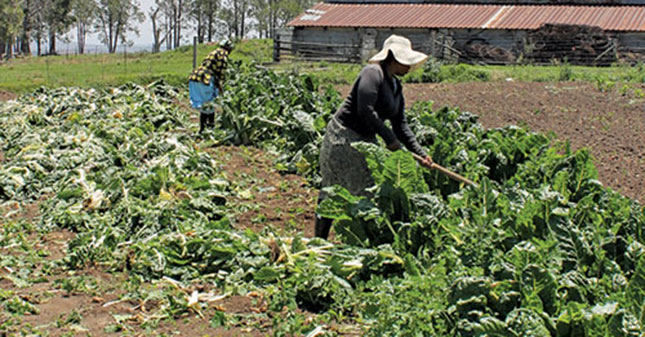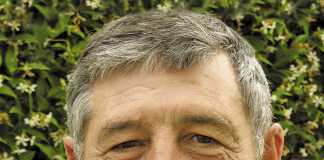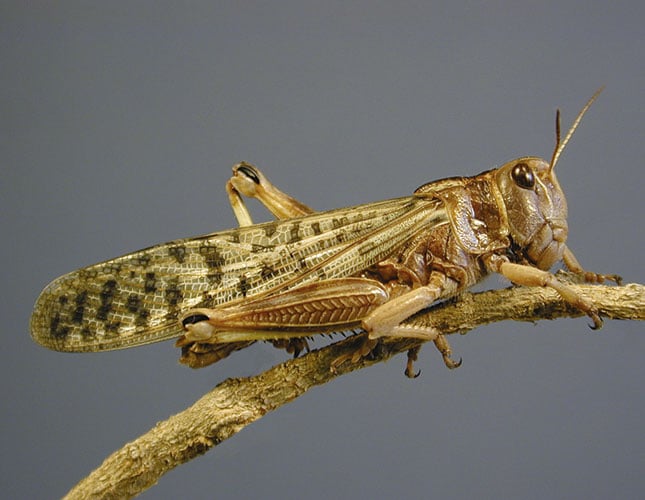
Photo: FW Archive
What are the gaps in our knowledge of the brown locust?
Population irruptions and swarming of insects, birds and antelope are prominent features in the Nama Karoo. Some of these phenomena have been changed or eliminated through farming and insecticide spraying. But the brown locust remains, alongside the Karoo caterpillar. While huge sums have been spent on controlling locust swarms for over a century, we still don’t know if the costs are warranted. Neither do we know enough about the ecological significance of these insects.
Swarms feed here, defecate there and die elsewhere, while predators track locust abundance cycles and movements. All this forms intricate patterns of dynamic food webs and nutrient recycling across the Karoo and beyond. Unceasing persecution of brown locusts since 1906 has affected this species as well as grasshoppers, pollinators and birds which either consume poisoned prey or can no longer feed on this staple food.
One objective of the SAEON is to investigate the effects of global climate change and land use changes. Locusts are an obvious case study: by observing their populations, it may be possible to see a picture of environmental change in the Karoo.
Records available since 1797 show that brown locust outbreaks appear to track large-scale phenomena such as climatic variations. Records of locust irruptions and crashes in the region extend over 200 years and are potential indicators of ecosystem integrity and climate change.
What are the challenges?
Much money and effort are repeatedly spent on killing locusts, but there is no evidence that spraying thousands of targets has any real impact on the course of a plague, which appears to be an unstoppable natural phenomenon.
In the 1986 campaign, 6 023t of insecticides were applied to 250 000 hopper bands and 40 000 locust swarms. This cost about R50 million, labour included, at the time, which was 17 times more than the normal income of the sheep farms that were treated.
Also lacking is our ability to predict locust outbreaks and their dispersal patterns, the ecological and economic costs of irruptions, and dynamically suitable artificial control measures. Part of the puzzle is the brown locust’s variable egg physiology and complex triggers for development which may render the species resilient to environmental pressures.
What do we know about the brown locust?
Historically, this locust reached plague status (> 5 000 adult swarms per year with escapes out of the Karoo) once or twice per decade. Outbreaks occur during the rainfall season, with at least a few hopper bands recorded in 90% of the summers.
Hopper bands and swarms only occupy patches within outbreak areas.
For instance, the large outbreak of 1986 was estimated to have occurred across five million hectares, with many separate hopper bands of typically several hundred thousand individuals occurring in areas of about one-sixth of a hectare each, on average, moving progressively across the veld.
At adulthood, these bands aggregate into swarms, each typically numbering some 25 million individuals, which on average, occupy about 14ha when roosting, and fly daily to new foraging patches, breeding sites and roosts, covering distances of up to 150km/day.
Swarms follow prevailing winds, skipping some farms before landing again. They occasionally disperse away from the Karoo into areas elsewhere in Southern Africa, reaching as far as Zimbabwe and Mozambique.
With insecticide applications being intensified in the past century, the population cycle (gregarious phase plus solitary phase) has become shorter, dropping from 24 years to 14 years. The gregarious phase is now shorter (six or seven years, down from 13) and returns sooner (seven years, down from 11).
This could be because the insecticide brings a premature population crash before the food resources are depleted. Only in arid areas where drought periods are long enough, are conditions suitable for diapausal (dormant) egg banks to build up rather than hatch more frequently and deplete the egg banks. This may explain why outbreaks do not typically originate in grasslands.
What is the role of predators in locust control?
Fluctuating populations make predator food webs dynamic. Between locust irruption periods, the resident predator populations also decline. While predator populations cannot respond rapidly enough to suppress locust outbreaks, they can suppress the low-density solitaria population and perhaps slow down the accumulation of a significant egg bank, thereby delaying the onset of the next outbreak.
The incidental poisoning of predators could reduce their effect on the locust population during its low-density phase, and could thus promote the unnaturally early initiation of the next outbreak.
How do climatic conditions affect outbreaks?
Seventy percent of the population variations could be explained by climatic patterns. Overall, locust population fluctuations correlate with El Niño patterns which track sea surface temperatures (SSTs) in the Indian Ocean: locust irruptions follow cold SSTs during the previous year and population crashes follow warm SST conditions.
The pattern involves a dry early summer followed by a wet late summer which leads to very dense egg beds. If this is followed by a dry winter, premature hatching of eggs during their period of inhibited hopper development does not occur. If good rains in early summer follow, eggs hatch synchronously and warm temperatures are conducive to the rapid development of hoppers. Scattered rainfall, typical of the Karoo, leads to scattered irruptions but occasional widespread frontal rains can result in outbreaks reaching plague proportions.
Another possibility is that the patchy patterns of Karoo rainfall, which affect changes in plant nutritional values, drive or suppress locust outbreaks. Following rain, plant protein levels increase quickly while carbon-based defences such as tannins build up more gradually.
Plants experience stress when the soil dries. If they are stressed before accumulating enough chemical defences, they remain palatable, and get consumed by hoppers, which develop quickly. By contrast, prolonged wet periods allow unstressed plants to build up defences against locust herbivory while prolonged dry intervals reduce plant nutritional values.
Thus, in the absence of quickly alternating wet and dry periods within a summer season, hoppers develop too slowly to drive outbreaks. So, measuring contents of plant protein and defence chemicals could be valuable for predicting the initiation and cessation of outbreaks.
Research has noted a 100km westward shift of the core areas of locust outbreaks suggesting that this is related to a westward shift in the 150mm rainfall isohyet. Alternatively, the outbreak shift could be due to veld management in the eastern part of the Karoo having promoted increases in ground cover by vegetation, reducing the areas of bare ground preferred by locusts.
What changes do you suggest to control strategies?
The locust control policy still requires the insects to be killed at the outbreak source to reduce the likelihood of swarms escaping the Karoo and invading crops. Not much has been done to directly reduce the vulnerability of crop farmers.
Alternative ways of directly reducing crop damage warrant attention.
These could be as simple as applying insect repellents that do not affect crops, such as was envisaged with the initial investigations by the Agricultural Research Council, with natural repellents. Protecting crops by aerial spraying of migrating swarms rather than hunting down hopper bands would potentially be cost-effective but goes against locust control policy.
How do locust plagues affect the Karoo veld?
No scientific investigation of the effects of locust herbivory on the Karoo veld has been done. But studies of the locust diet, food preferences and consumption indicate no competition with sheep except, perhaps, in poorly-managed veld. Locusts only interface with a flock for a brief time before they disperse, leaving behind valuable nutrient parcels. The livestock browsing/grazing value may improve following intense defoliation by locusts.
Locust frass has higher concentrations of nutrients than the leaves consumed. Locusts deposit large quantities of frass in the patches where they feed or rest. About 2,3 billion kg of frass were deposited across the Karoo during the 1986 outbreak, equal to 14kg N/ ha/day. Locust bodies, bearing nutrients, are often concentrated in patches where they decompose.
Locusts provide several ecosystem services, their loss being a cost, but the overall effects of the long-term poisoning of an entire biome are not understood. It is likely to affect biodiversity and thus degrade the ecosystem. It could also lead to an increase in grass and veld fires. No experimental ‘control’ areas that have never been sprayed are available to study.
Email [email protected].

